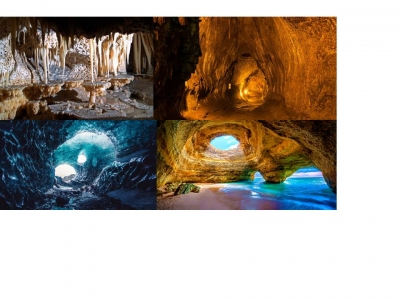
Caves are underground spaces or hole that are large enough for someone to enter. They form in many different ways, but mostly because of rock in the Earth’s surface being worn away or crumbling. Caves usually have lots of interesting and exciting features to explore.
There are many types of caves formed through different processes: some are small, and it is difficult for man to penetrate into; others, on the contrary, stretch underground for tens or hundreds of kilometres, reaching depths of over 2,000 m. Formation processes control length, development and shape of a cave, and also the difficulties that will arise when exploring them. Most of the longest and deepest caves do not consist in an isolated cavity, but they form a system, which at times may be very complex, made of rooms, sinkholes, shafts, meanders, canyons, interconnecting galleries, which are arranged to form a system or karst complex.
Large quantities of underground water move through karst systems, caves may therefore be classified in different sub-areas, i.e. occupied by air and completely dry or scoured by streams, they may be flooded at times, or permanently invaded by fresh and salt water.
Caves are found all over our planet. Some are small, single spaces, but others contain many chambers, linked by tunnels to form a huge maze of different areas. Although most caves are found in rock, some form in ice or lava.
Solutional caves
These are the most common type of cave. They are created when a build up acidic water dissolves the rock around it. Holes and tunnels start to appear, getting bigger and bigger as more rock dissolves and is washed away.
Solution caves are formed when groundwater seeps underground via cracks, faults, joints, bedding places, and other surface openings. Over geological epochs, small cracks in the rock become large cave systems. Limestone solution caves are very picturesque as they are often adorned with cave formations like stalactites and stalagmites formed by calcium carbonate precipitation. Such caves are formed by the dissolution of limestone by acidic water (water with dissolved carbonic acid).
Lava caves
When lava flows slowly over land around a volcano, it can harden on the surface, leaving liquid lava flowing underneath. This liquid drains away, leaving a hollow tube of rock that forms a cave.
When hot liquid lava flows down the slope of a volcano, the surface of the lava cools and solidifies. However, hot liquid lava continues to flow beneath the solidified surface and when the flow stops, a hollow tube remains. Such types of caves are called lava tubes. Lava mold caves, rift caves, inflationary caves, and volcanic conduits are other caves formed by volcanic activity. The Kazumura Cave in Hawaii is an example of a 65.8 km long lava tube.
Ice caves
Ice melting on top of a glacier can form a stream or waterfall that flows through the glacier. Eventually, this flowing water will hollow out part of the glacier, creating an ice cave.
The second type of ice cave occurs either when frigid winter air settles into downward-leading caverns where it cannot be forced out or when moisture freezes in currents of cold air. Frozen lakes, icicles, and ice draperies are common formations. Helictite-like icicles also form where air currents deflect the freezing water. The splendid ice deposits formed in the lava caves of the northwestern United States are dwarfed by the limestone ice-cave systems of the Alps.
Sea Caves
These are formed by waves constantly battering against cliffs along the seashore. This leads to cracks appearing in the cliffs that get larger as beating waves continue to wear away the rock.
Sea caves are often a major tourist attraction. Some sea caves can be accessed only by boats during low tide while others are more easily accessible and occur along beaches where it is possible to walk into the caves. Cathedral Cove Sea Cave, in Coromandel, New Zealand is an example of a sea cave.
Picture Credit : Google
